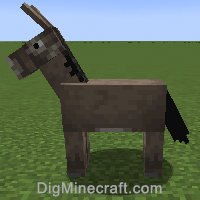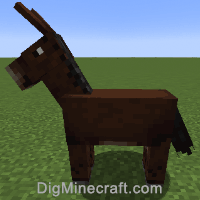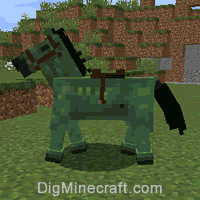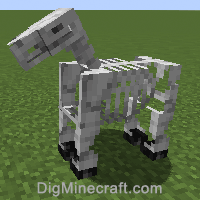NBT Tags for Horse in Minecraft (Java Edition 1.10)
This Minecraft tutorial explains the NBT tags (formerly called data tags) that you can use for a horse in Minecraft Java Edition (PC/Mac) 1.10.
TIP: If you are not running Minecraft Java Edition (PC/Mac) 1.10, find NBT tags for horse in another version of Minecraft:
Background
In Minecraft Java Edition 1.10, the entity value for a horse is EntityHorse. This EntityHorse entity has a unique set of data tags that can be used in Minecraft commands such as: /summon, /entitydata, /give, /fill, /setblock, /testfor.
EntityHorseis used as the entity value for horse, donkey, mule, zombie horse and skeleton horse in Minecraft 1.10:





What are NBT tags (formerly called Data Tags)?
NBT tags allow you to set certain properties of an entity (such as EntityHorse). The NBT tag is always surrounded in {} such as {Type:0}. If there is more than one NBT tag used in a game command, the NBT tags are separated by a comma such as {Type:0, Variant:259}.
List of NBT Tags
Here is a list of the NBT tags that you can use for EntityHorse in Minecraft Java Edition (PC/Mac) 1.10:
| NBT Tag | Value (Description) | Works With |
|---|---|---|
| Type | 0 (The horse is a normal horse) Example |
/summon /entitydata |
| Variant | number (The variant for the horse. This determines the appearance of the horse) Example |
/summon /entitydata |
| Tame | 0 (The horse is wild) Example |
/summon /entitydata |
| SaddleItem | If the horse is wearing a saddle, it is used to specify the Minecraft id for the saddle and number of saddles worn by the horse Example |
/summon /entitydata |
| ArmorItem | If the horse is wearing horse armor, it is used to specify the Minecraft id for the horse armor and number of horse armor items worn by the horse Example |
/summon /entitydata |
| ChestedHorse | 0 (The horse is not carrying a chest) Example |
/summon /entitydata |
| Temper | number (The temper of the horse which is a number from 0 to 100. The higher the number, the easier it is to tame the horse.) Example |
/summon /entitydata |
| InLove | ticks (The number of game ticks that the horse is in love mode and will try to breed with another horse) Example |
/summon /entitydata |
| HasReproduced | 0 (The horse has not reproduced) Example |
/summon /entitydata |
| Bred | 0 (The horse has not bred) Example |
/summon /entitydata |
| Age | ticks (The age of the horse in game ticks. Use 0 or higher for an adult. Use a negative number such as -25000 for a baby.) Example |
/summon /entitydata |
| ForcedAge | ticks (When a baby horse matures, the Age data tag will be set to ForcedAged. However, there have been bugs with this data tag so it may not work properly.) Example |
/summon /entitydata |
| EatingHaystack | 0 (The horse is standing normally) Example |
/summon /entitydata |
| Leashed | 0b (The horse is not leashed) Example |
/summon /entitydata |
| Leash | Used with the Leashed data tag. Indicates the coordinates of the fence that the horse is leashed to. Example |
/summon /entitydata |
| SkeletonTrap | 0 (The horse becomes a skeleton trap) Example |
/summon /entitydata |
| SkeletonTrapTime | ticks (The number of game ticks that the skeleton trap has not been triggered. A skeleton trap will only trigger when a player is within 10 blocks of the trap. Once the SkeletonTrapTime reaches 18000 ticks, the untripped skeleton trap will despawn) Example |
/summon /entitydata |
| CustomName | name (The name to assign to the horse. If the name has spaces, you need to surrounded the name value in "".) Example |
/summon /entitydata |
| Health | number (The number of health points the horse has) Example |
/summon /entitydata |
| AbsorptionAmount | number (The number of absorption health points the horse has) Example |
/summon /entitydata |
| Invulnerable | 0 (The horse will take damage like normal) Example |
/summon /entitydata |
| PersistenceRequired | 0 (The horse will despawn naturally) Example |
/summon /entitydata |
| NoAI | 0 (The horse will have artificial intelligence and will move/behave like normal) Example |
/summon /entitydata |
| Silent | 0 (The horse will make its usual noises in the game) Example |
/summon /entitydata |
| Fire | ticks (The number of game ticks until the horse is no longer on fire - there are 20 ticks in a second) Example |
/summon /entitydata |
| PortalCooldown | ticks (The number of game ticks until the horse can go through a portal again - there are 20 ticks in a second) Example |
/summon /entitydata |
| Air | ticks (The number of game ticks the horse has air left for) Example |
/summon /entitydata |
| UUIDLeast | A number that specifies the right half of the UUID for the horse (use UUIDLeast and UUIDMost to target/find a particular horse in the game) Example |
/summon /entitydata |
| UUIDMost | A number that specifies the left half of the UUID for the horse (use UUIDLeast and UUIDMost to target/find a particular horse in the game) Example |
/summon /entitydata |
| id | EntityHorse (The entity value used to represent a horse in the EntityTag or Passengers tag) Example |
/summon /give |
| Passengers | The mob that is riding on the horse. Use the entity value for the passenger mob Example of skeleton as passenger |
/summon /entitydata |
NBT Tag Examples
To summon a wild horse:
/summon EntityHorse ~ ~ ~ {Type:0}
To summon a tame donkey wearing a saddle and chest:
/summon EntityHorse ~ ~ ~ {Type:1, Tame:1, SaddleItem:{id:saddle,Count:1}, ChestedHorse:1}
To summon a tame zombie horse wearing a saddle:
/summon EntityHorse ~ ~ ~ {Type:3, Tame:1, SaddleItem:{id:saddle,Count:1}}
To summon a tame skeleton horse wearing a saddle:
/summon EntityHorse ~ ~ ~ {Type:4, Tame:1, SaddleItem:{id:saddle,Count:1}}
To summon a horse that has 4 custom drops (3 redstone, 1 gold horse armor, 2 iron ingot and 7 gold ingot). Use a command block to run this command:
/summon EntityHorse ~ ~1 ~ {ArmorItems:[{Count:3,id:redstone}, {Count:1,id:golden_horse_armor}, {Count:2,id:iron_ingot}, {Count:7,id:gold_ingot}], ArmorDropChances:[1.0f,1.0f,1.0f,1.0f]}
To give the closest player a horse spawn egg in Minecraft Java Edition (PC/Mac) 1.10:
/give @p spawn_egg 1 0 {EntityTag:{id:EntityHorse}}
Target Selectors
Before we finish discussing data tags, let's quickly explore how to use the @e target selector. The @e target selector allows you to target entities in your commands. If you use the type=EntityHorse value, you can target horses:
@e[type=EntityHorse]
You can also add a radius value to target horses within a certain radius of blocks (for example, r=5 lets you target horses within a 5 block radius of where the command is run):
@e[type=EntityHorse,r=5]
Target Selector Examples
To change all horses to baby horses within a 5 block radius:
/entitydata @e[type=EntityHorse,r=5] {Age:-25000}
To test for all horses within a 50 block radius:
/testfor @e[type=EntityHorse,r=50]
To summon a lightning bolt at all horses:
/execute @e[type=EntityHorse] ~ ~ ~ /summon LightningBolt
To kill all horses:
/kill @e[type=EntityHorse]
Next, learn how to use the game commands in Minecraft.
Horse Variants
Here are the variants for a horse in Minecraft:
Command Examples
Here are some game command examples for a horse in Minecraft:
Command Generators
If you need help, you can use these tools to automatically generate commands for you:
Advertisements













